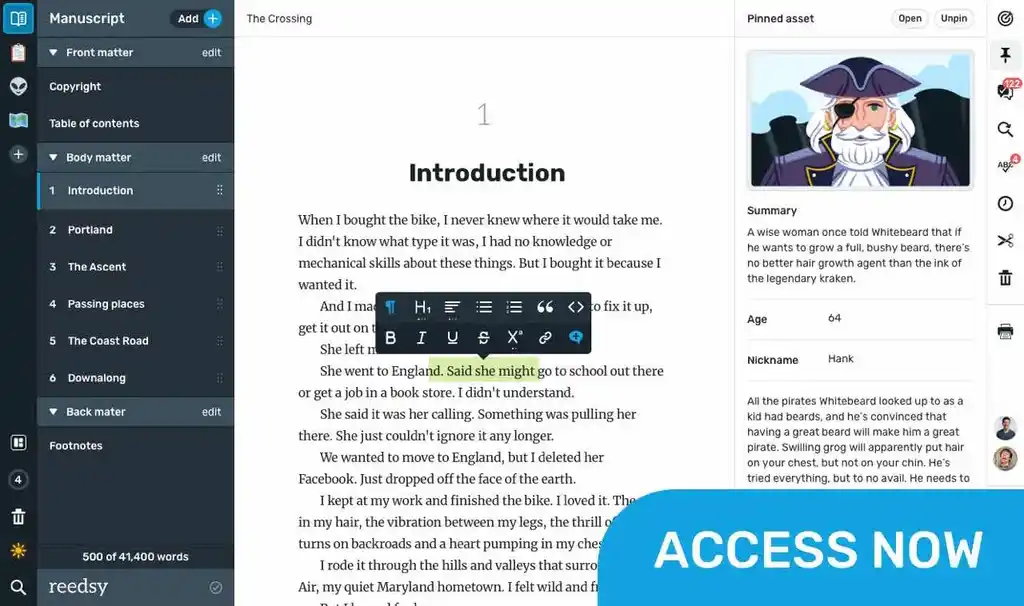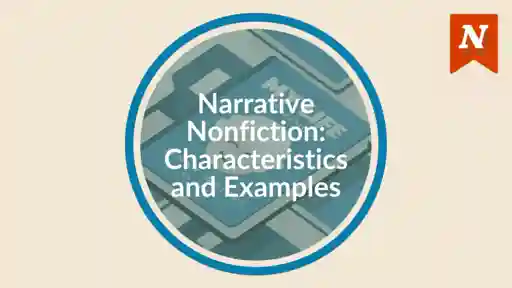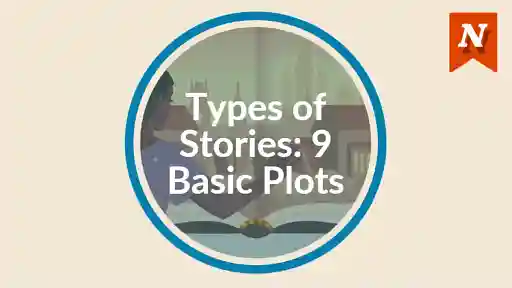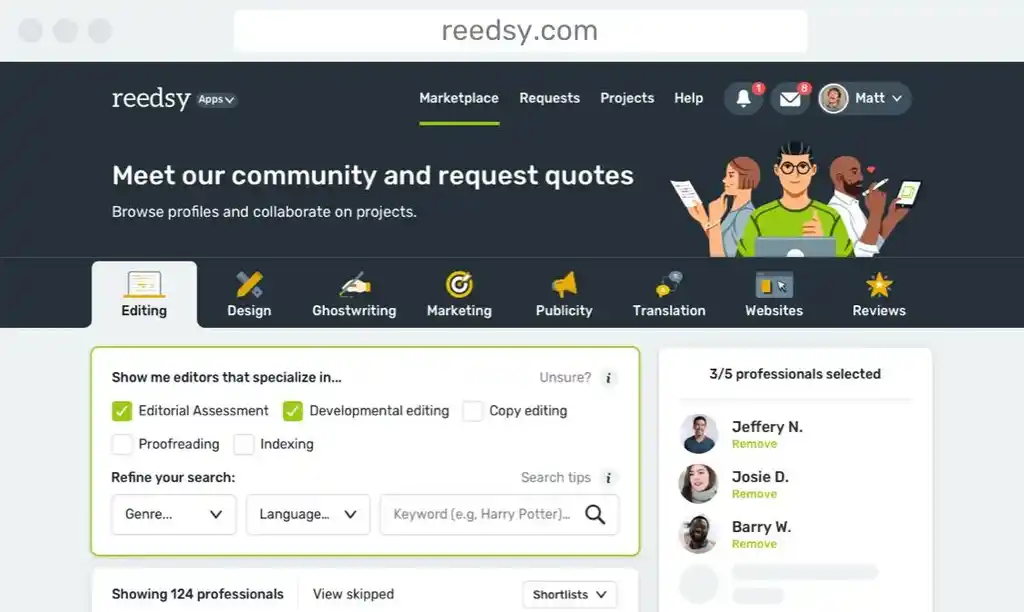Dialogue is the verbal exchange between characters that advances the plot, reveals character traits, and lends authenticity to your narrative. Some authors also consider a character’s “inner voice” to be a type of dialogue. In any case, however it’s used, dialogue can be a powerful narrative tool!
But not all dialogue functions the same way. In this guide, we’ll explore five major types of dialogue in fiction, complete with examples, tips, and a bonus section on more nuanced dialogue techniques.
Not sure which one to use? See our flow chart below to see which type of dialogue would best suit your scene — then read on to learn more.
1. Outer dialogue
Outer dialogue is the spoken interaction between characters — what readers “hear” when people in your story speak out loud. When someone refers to “dialogue” in fiction, 99% of the time, they’re talking about outer dialogue.
So, how should you use outer dialogue? Here are the main things it can do:
- Advance the plot. Key information and plot twists often unfold in conversation. Think of iconic twists in books and films, like the “I am your father” moment in The Empire Strikes Back. Much of the time, these revelations are conveyed through dialogue.
- Reveal character relationships. Word choice and tone show the power dynamics and overall relationship between speakers. If Person A is curt and dismissive in conversation with Person B, for example, the reader might infer that Person B is their professional subordinate or someone who has annoyed them (or both!).
- Create tension or conflict. Snappy exchanges or heavy silences keep readers hooked. Remember that sometimes the absence of dialogue is more powerful than anything your characters could say.
Example: Pride and Prejudice by Jane Austen
“You are dancing with the only handsome girl in the room,” said Mr. Darcy, looking at the eldest Miss Bennet.
“Oh, she is the most beautiful creature I ever beheld! But there is one of her sisters sitting down just behind you, who is very pretty, and I dare say very agreeable. Do let me ask my partner to introduce you.”
“Which do you mean?” and turning round, he looked for a moment at Elizabeth, till, catching her eye, he withdrew his own, and coldly said, “She is tolerable: but not handsome enough to tempt me; and I am in no humour at present to give consequence to young ladies who are slighted by other men.”
Darcy’s dialogue here establishes the groundwork for their long arc from disdain to intimacy. His insult doesn’t just inform us of his pride; it also ignites the central conflict in their dynamic. In other words, this passage checks all the “outer dialogue” boxes noted above.
Remember, outer dialogue is often the best choice when the emotional charge of the moment comes from interaction, not just internal reflection or narration. Don’t be afraid to use it generously in your own work.
Writing Tip: To make your dialogue sound natural, read it aloud. If you stumble or it sounds robotic, your characters probably wouldn’t say it that way either!
2. Inner dialogue
Inner dialogue is the internal monologue of a character: their thoughts, reflections, or self-talk. It provides emotional depth and reveals not just what a character does, but why.
So what’s the difference between inner and outer dialogue? You’ve probably grasped it already, but basically, it’s all about where the words live: aloud in conversation, or unspoken in a character’s mind. Understanding that difference is key to using inner dialogue effectively.
Inner dialogue is typically used to:
- Show character motivation. A character’s inner voice typically won’t shy away from what they want. Then again, sometimes a character has conflicting motivations — in which case, their inner dialogue might manifest as an argument with themselves.
- Express unspoken emotions like doubt, desire, or fear. While outer dialogue may hint at these difficult emotions, inner dialogue can reveal true feelings. Think of someone who keeps insisting, verbally, that they’re “totally fine”; you could use their inner dialogue to tell a different story.
- Create intimacy between character and reader. Lastly, being “inside” a character’s head helps readers a) relate to the character and b) get more invested in their story.
Example: Harry Potter and the Half-Blood Prince by J.K. Rowling
A fierce battle was raging inside Harry's brain:
She's Ron's sister.
But she's ditched Dean!
She's still Ron's sister.
I'm his best mate!
That'll make it worse.
If I talked to him first–
He'd hit you.
What if I don't care?
He's your best mate!
In this moment from Harry Potter and the Half-Blood Prince, Harry’s feelings for Ginny clash with his loyalty to Ron — a moment of pure inner chaos. Without any outer dialogue, readers are drawn straight into Harry’s thoughts, making his turmoil feel immediate and personal.
But while it’s still fairly common, inner dialogue is not used quite as frequently as outer dialogue in fiction. So, for those who may still be wondering about effective usage, you should include inner dialogue when you want to:
- Add deeper layers to introspective scenes;
- Highlight any conflict between a character’s words and thoughts; or
- Show the tension of a character’s indecision.
Writing Tip: Use inner dialogue sparingly in high-action scenes, as too much introspection can slow your pacing. Instead, insert brief flashes of inner thought that reflect urgency, confusion, or instinct to reveal what’s driving the character in that moment.
3. Indirect dialogue
Indirect dialogue summarizes what was said, rather than quoting it directly. It’s a clever way to keep your story moving, especially when the specifics of a conversation aren’t important.
For instance, imagine this scene at a family dinner:
She apologized for being late and made some small talk with her aunt about traffic. Then, as they cleared the plates, she dropped the bomb: “I’m moving to Australia.”
In this example, indirect dialogue is used to gloss over casual chatter and direct the reader’s focus to the big reveal.
Indirect dialogue comes in particularly handy when you have to:
- Maintain pacing. Summarize words with indirect dialogue to keep things engaging. For instance, if there’s a scene where your character attends a lecture, you can simply recap the lecture’s contents — rather than including the whole transcript.
- Guide the reader’s focus. Skip the clutter and steer the reader’s attention to whatever matters most to your scene.
- Show the passage of time. Condense long or repeated exchanges over time into a quick line or two. This is useful for recurring arguments or long-form exchanges, as it gives the reader a sense of continuity
- Reveal character bias. People often recount dialogue, rather than quoting it verbatim, which reveals a lot about their perspective. By twisting someone’s words or downplaying a compliment, you can explore unreliable narration and emotional filters.
Example: Norwegian Wood by Haruki Murakami
Naoko said she wanted to hear about how I was spending my days. I talked about the student strike and Nagasawa. This was the first time I had ever said anything about him to her. I found it challenging to give her an accurate account of his odd humanity, his unique philosophy, and his uncentred morality, but Naoko seemed finally to grasp what I was trying to tell her.
Here, we don’t hear the exact words the characters used, but we understand the emotional undercurrents at play. The real tension lies in how hard it is for the narrator to explain Nagasawa’s complicated morality — and how meaningful it is when Naoko finally seems to understand. This way, Murakami centers the narrator’s subjective experience without slowing down the pace too much.
Indirect dialogue is your ally when you want to highlight what's unsaid rather than repeat things verbatim. It’s especially effective for setting up dramatic moments and adding context and atmosphere to the story!
Writing Tip: If a conversation doesn’t add tension, emotion, or new information, use indirect dialogue. This helps you skip over fluff and makes key dialogue land with more impact.
4. Dialect
Dialect uses regional or cultural speech patterns to reveal where a character is from, how they were raised, or how they see the world. When done well, it adds voice, authenticity, and texture to your writing; but just like seasoning, a little goes a long way.
You can use dialect to:
- Conjure a certain atmosphere or backdrop. A few turns of phrase can transport readers to the Scottish Highlands or a Mumbai street corner without excessive exposition.
- Indicate identity, class, or education. For example, a character who says “Ain’t got none” might come from a rural, working-class background, while one who says “I haven’t any” may signal more formal schooling or social privilege.
- Make the characters’ speech feel authentic. Dropped syllables and informal grammar can be used to reflect genuine local speech.
Example: Of Mice and Men by John Steinbeck
“Well, that girl rabbits in an' tells the law she been raped. The guys in Weed start a party out to lynch Lennie. So we sit in a irrigation ditch under water all the rest of that day. Got on'y our heads sticking outa water, an' up under the grass that sticks out from the side of the ditch. An' that night we scrammed outa there.”
This passage is a great example of how dialect can show character and setting. The clipped sentences, dropped consonants (“an’,” “got on’y,” “outa”), and rural slang (“scrammed,” “rabbits in”) firmly place the speaker in Depression-era California and evoke the working-class voice of itinerant ranch laborers.
Steinbeck captures speech that feels rough-edged and regionally grounded, without resorting to heavy nonstandard spelling. Indeed, when writing dialect, a few quirks go a long way!
If you wish to use dialect in your own story, be sure to research speech patterns and regional expressions (contemporary or historical). This will help you strike the right balance between authenticity and clarity.
Writing tip: Above all, don’t overdo it with your dialect. Your characters should never feel like caricatures — and readers should never feel overwhelmed trying to interpret their speech. As William Faulkner once advised:
I think it best to use as little dialect as possible, because it confuses people who are not familiar with it. Nobody should let the character speak completely in his own vernacular. It’s best indicated by a few simple, sparse but recognizable touches.
5. Monologue
A monologue is a long, uninterrupted speech by a character. It often reveals their most private thoughts, beliefs, or emotions. Whether spoken aloud or thought silently to themselves (in which case it’s also “inner dialogue”), a monologue can slow the pace of a story and draw readers in.
Writers often use monologues to:
- Give a character’s worldview or backstory in their own words. A war veteran describing a pivotal moment on the battlefield can tell us more than pages of non-first-person description.
- Deliver emotional high points with impact and intensity. Whether heartfelt, humorous, or harrowing, monologues are well-suitedl to deliver emotional resonance.
- Let characters speak for themselves in a raw, unfiltered way. No narrator stepping in, no interruptions. This makes monologues ideal for showing a character’s deepest vulnerabilities.
Example: Hamlet by William Shakespeare
To be, or not to be: that is the question:
Whether 'tis nobler in the mind to suffer
The slings and arrows of outrageous fortune,
Or to take arms against a sea of troubles,
And by opposing end them? To die: to sleep;
… [continues through the soliloquy] …
But that the dread of something after death,
The undiscover'd country from whose bourn
No traveller returns, puzzles the will
And makes us rather bear those ills we have
Than fly to others that we know not of?
Thus conscience does make cowards of us all;
And thus the native hue of resolution
One of literature's most famous monologues! No other character interjects, so we’re immersed in Hamlet’s internal world — following the arc of his thought from abstract suffering to a clear moral crossroads. The emotional tension builds line by line, making this a crucial moment in the play.
Monologues work best when used sparingly, often in scenes that demand deep reflection. To write a gripping monologue of your own, ground it in specific emotion — like grief, doubt, or anger — and build toward a moment of realization. Let the character speak without filters, but make sure what they’re saying still pushes the story forward.
Writing Tip: Use the rhythm and structure of the monologue to reflect the character’s emotional state. A rambling, repetitive monologue can mirror panic or obsession; a clipped, sparse one might reveal shock.
Bonus dialogue tools
Beyond the main types, masterful dialogue often includes a few nuanced subtypes. Let’s finish off this post by discussing a few of them.
Subtext
Subtext is basically what’s not said — the tension between the actual lines of dialogue. This is used when characters sidestep the truth due to fear, pride, or discomfort. With a bit of additional context, though, the reader can still figure out what they mean.
Example: “Don’t worry about it,” she said quietly. She wouldn’t look him in the eye.
Here, the speaker tells her friend not to worry — but her flat demeanor and refusal to look at him imply something else. The subtext: maybe he should be worried after all.
Tag beats
Another fairly simple dialogue tool, tag beats are small actions or gestures placed alongside dialogue. They can be used to convey emotions, create tension, or indeed, to introduce subtext!
Example: “Leave it,” he said, dropping the wrench.
The gesture shows emotion — maybe resignation or anger — without spelling it out too explicitly.
Sarcasm or euphemism
Characters often use irony or polite phrasing to either skirt the subject or downplay their true feelings.
Example: “Oh great, another flat tire. Perfect.”
By juxtaposing an upbeat reaction to an obviously unfortunate event, the speaker's sarcasm highlights their irritation more effectively than blunt complaint.
Great dialogue must be crafted with care and sharp attention to detail. Start by thinking about what your scene really needs — whether it’s movement, tension, or emotional insight.
Use outer dialogue to make scenes feel real and alive. Add inner dialogue when you want readers to understand what’s going on beneath the surface. Turn to indirect dialogue to keep the pace brisk, and reach for monologue when a character needs space to speak their truth. Dialect, beats, and subtext can bring even more texture to your writing.
Ready to take it further? Check out this free dialogue course to sharpen your skills and make every line count.











Excellent advice and examples.
Jill - Over 3 years ago